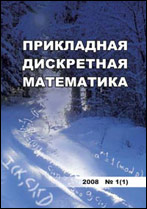|
Applied Graph Theory
$\langle 2\rangle$-exponents of shift register transformations nonlinearity dipgraphs
V. M. Fomichevab, V. M. Bobrovc
a Financial University under the Government of the Russian Federation, Moscow, Russia
b Federal Research Center “Computer Science and Control”, RAS, Moscow, Russia
c Moscow Engineering Physics Institute (National Nuclear Research University)
Abstract:
The matrix-graph approach is used to estimate sets of essential and non-linear variables of coordinate functions of the vector space transformations product. Estimates are obtained by multiplying binary mixing matrices or digraphs of multiplied transformations in the case of the set of essential variables, or by multiplying ternary nonlinearity matrices or corresponding nonlinearity digraphs with the arcs marked by numbers from the set $\{0, 1, 2\}$. For powers of a given transformation the non-trivial estimates domain is limited by the mixing matrix (digraph) exponent in the case of the essential variables and by the nonlinearity matrix (digraph) $\langle 2\rangle$-exponent in the case of the nonlinear variables. Let $f(x_0,\dots,x_{n-1})$ be the feedback function of shift register, $D=\{d_0,\dots,d_m\}$ be the set of its essential variables (registers extraction points), $1<m\leq n$, $0=d_0<d_1<\ldots<d_m<n$, $E=\{e_0,\dots,e_l\}$ be the set of its nonlinear variables (registers nonlinear extraction points), $1<l\leq n$, $e_0<e_1<\ldots<e_m<n$, and shift register transformation nonlinearity digraph $G$ be $\langle 2\rangle$-primitive. Then $\langle 2\rangle$-exponent of $G$ is not greater than $F(L)+1+n+\Delta_f$, where $F(L)$ is a Frobenius number of the set $L$ of the lengths of all digraph simple circuits, $\Delta_f=\max_{i\in D^0\cup D^1}\mu(i-1)$,
\begin{gather*} \mu(u)= \begin{cases} \min\{u-e(u),u-d(u)+n-e_l\}, & e_0\leq u<n; \\ u-d(u)+n-e_l, & 0\leq u<e_0, \\ \end{cases}\\ D^0=\{d_s\in D, 1\leq s\leq m: d_{s-1}-e(d_{s-1})\leq\lambda, e_0\leq d_{s-1}<n\}\cup S_0(n), \\ D^1=\{d_s\in D, 1\leq s\leq m: 0\leq d_{s-1}<e_0 \text{or} d_{s-1}-e(d_{s-1})>\lambda\}\cup S_1(n), \end{gather*}
where $d(u)$ is the greatest number of $D$ such that $d(u)\leq u$, $0\leq u<n$; $e(u)$ is the greatest number of $E$ such that $e(u)\leq u$, $e_0\leq u<n$; $S_0(n)=S_1(n)=\emptyset$, if $d_m=n-1$; $S_0(n)=\{n\}$, if $d_m<n-1$ and $d_m\in E$; and $S_1(n)=\{n\}$, if $d_m<n-1$ and $d_m\in E$. In the case of the variable $x_{n–1}$ being essential for the function $f(x_0,\ldots,x_{n–1})$, the exact formula for the $\langle 2\rangle$-exponent of the nonlinearity digraph has been derived. Calculation examples are presented. The results can be used to estimate the nonlinearity characteristics of cryptographic functions constructed from iterated register transformations.
Keywords:
shift register transformation, nonlinearity digraph, $\langle2\rangle$-primitivity, local $\langle2\rangle$-primitivity, $\langle2\rangle$-exponent of digraph, local $\langle2\rangle$-exponent of digraph.
Citation:
V. M. Fomichev, V. M. Bobrov, “$\langle 2\rangle$-exponents of shift register transformations nonlinearity dipgraphs”, Prikl. Diskr. Mat., 2022, no. 55, 77–87
Linking options:
https://www.mathnet.ru/eng/pdm761 https://www.mathnet.ru/eng/pdm/y2022/i1/p77
|

|




 Contact us:
Contact us: Terms of Use
Terms of Use
 Registration to the website
Registration to the website Logotypes
Logotypes








 Citation in format
Citation in format 